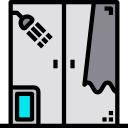
Wet Rooms
Wet rooms are open-plan bathrooms allowing people to shower without a shower tray or screen. This makes bathroom accessibility far easier for people in wheelchairs with limited mobility.

Wet Room Size Guide
To meet tight planning regulations and the size of your home, the design of a wet room is critical.

What Is A Wet Room?
Wet rooms are bathrooms with shower areas, a toilet and sink, and drainage on the floor.

How To Clean A Wet Room
You don’t have to deal with many complicated components like drainage when cleaning wet rooms.

Wet Room Costs
A Walk in bath work by having a door so you can enter.

Wet Room Installation Questions
You might use concrete flooring or tiles for a wet room.

Bathing Aids
With the aid of the bath stairs, you can quickly get in and out of the tub.
[lmt-post-modified-info]
Wet Rooms Key Points
- People who prefer showers to baths are increasingly embracing wet rooms as a space-saving alternative for bathrooms with limited space.
- A full wet room gives you additional room in the bathroom for showering.
- You will have a walk-in shower in a wet room as you have no shower enclosure that you will need to navigate in and out of.
- Install a standalone bath with statement walls in your main bedroom or bathroom if possible.
- Wet rooms give a great minimalist look.
- You can prevent water damage by having a showering area blocked off by a glass screen/panel to prevent water from escaping.
- Make sure you get the proper grip. Not all surfaces are safe when wet. Check the slip rating so you can get an extra grip.
- Walk-in showers are great for people with limited mobility.
What Is A Wet Room?
The term “Wet Room” (sometimes known as shower room) refers to a bathroom that includes a shower, a sink, and a toilet with a water supply. The shower drain is often located in the bathroom, where the water is released.
Shower enclosures aren’t necessary for open wet rooms, but many customers prefer them for their ability to contain spillage and their ability to create a more personal space. This allows for clean, safe spaces and smooth transitions during bathing and showering.
Wet Room Ideas
People who prefer showers to baths are increasingly embracing wet rooms as a space-saving alternative for bathrooms with limited space.
This is the most crucial difference between the two. A flat floor and clear drainage are the results of meticulous work. Getting underfloor heating can keep the room warm without needing a radiator.
Waterproofing For A Wet Room
The walk-in shower area and surrounding wall regions must be removed and then covered with a polymeric coating for waterproofing a wet room system. After putting the furniture and décor in place, the bathroom will be glazed and tiled.
The home’s water volume may be increased by a small threshold on the bathroom door. Moisture levels are stable due to the bathroom floors’ wet room design.
How To Build A Wet Room?
Installing a wet room is a significant investment. The price and time of installing a wet room depend on features. You must get tiles attached to each wall during wet room installation.
To ensure that water drains effectively, you should make the necessary adjustments to the floor, so there is a slop to the drain.
Creating A Stylish Design In Your Wet Room
It’s no surprise that open-concept living is becoming more popular and that many prefer replacing their old, conventional bathrooms with sleek, contemporary alternatives.
These wet room bathrooms have a European feel with luxurious walk-in showers and tiled flooring.
More accessible To Clean Than Other Bathroom Types
Everything within a traditional bathroom, such as the shower stall and the tub, has cleaning and maintenance steps. Wet rooms reduce this, allowing you to enjoy a more abundant bathroom experience.
Wet Rooms Works For Small Bathrooms
It also gives you additional room in the bathroom for showering. It doesn’t matter how tiny your space is; a dry room may help you feel its size. Removing your old shower curtain can completely transform the aesthetic of the area.
Do You Need A Shower Tray?
With a wet room, you do not need shower trays as the drain is sunk into the room’s floor, meaning the water can go on the bathroom tiles.
Walk-In Shower In A Wet Room
You will have a walk-in shower in a wet room as you have no shower enclosure that you will need to navigate in and out of. This makes it great for people with limited mobility or in a wheelchair.
Are Wet Rooms A Good Idea?
A wet room has many benefits. They are great for a bathroom that has limited space or for someone who has limited mobility and needs more space.
Getting The Right Flooring
You can get a whole range of flooring for your solid and wooden floors. You can get wet room trays or floor tiles. A wet room tray can make the set up quicker than floor tiles.
Disabled Wet Room Ideas
If you or someone in your household has a disability, designing a wet room can provide a safer and more accessible bathing experience. Here are some disabled wet room ideas to consider:
- Non-Slip Flooring – Choose a flooring material that provides traction to prevent slipping, such as textured ceramic tiles or vinyl flooring with a non-slip surface.
- Walk-In Shower – A walk-in shower with no curb or threshold makes it easy to enter and exit without the risk of tripping. It can also be equipped with a handheld showerhead for added convenience.
- Grab Bars – Install grab bars in the shower area and around the toilet to provide support and stability when moving around the wet room.
- Shower Seats – A shower seat can provide a safe and comfortable place to sit while bathing. You can install fold-down seats to save space when not in use.
- Wide Doorway – Ensure the doorway is wide enough to accommodate a wheelchair or other mobility device, typically at least 36 inches wide.
- Drainage – Proper drainage is critical in a wet room to prevent water from pooling and causing slip hazards. Consider installing a linear drain or sloping the floor toward a central drain.
- Colour Contrast – Choose colours that provide a high contrast level to help visually impaired individuals navigate the space more easily.
When designing a disabled wet room, it’s important to consult with a professional to ensure that it meets your specific needs and conforms to any relevant building codes or accessibility standards.
Where To Get Mobility Showers UK
There are several options for getting mobility showers in the UK:
- Specialist retailers – Many retailers in the UK specialise in mobility aids and equipment, including mobility showers. These retailers can provide various options and expert advice to help you choose the right mobility shower.
- Bathroom design and installation companies – Many companies specialising in bathroom design and installation can also provide mobility showers as part of their services. They can provide a tailored solution that fits your requirements and can often handle the installation process.
- Local councils – Depending on your circumstances, you may be eligible for assistance from your local council to help with the cost of a mobility shower. Contact your local council to find out if you qualify for financial aid.
- Healthcare providers – Your healthcare provider may be able to recommend specific mobility shower options based on your needs.
It’s important to carefully consider your needs and preferences when selecting a mobility shower and to consult with a healthcare professional or occupational therapist if you have any questions or concerns.
Small Wet Room Ideas For Disabled
Designing a small wet room for disabled individuals requires careful consideration to ensure that the space is safe, functional, and accessible. Here are some small wet room ideas for people with disabilities:
- Non-Slip Flooring – Choose a flooring material that provides traction to prevent slipping, such as textured ceramic tiles or vinyl flooring with a non-slip surface.
- Compact Walk-In Shower – A compact walk-in shower with no curb or threshold can provide a safe and easy-to-access bathing option in a small space.
- Fold-Down Shower Seat – A fold-down shower seat can provide a safe and comfortable place to sit while bathing and can be easily stored away when not in use.
- Wall-Mounted Grab Bars – Install wall-mounted grab bars in the shower area and around the toilet to provide support and stability when moving around the wet room.
- Sliding Door – A sliding door can save space in a small wet room and be easier to open and close than a traditional swinging door.
- Handheld Showerhead – A handheld showerhead can provide added convenience and flexibility when bathing in a small wet room.
- Bright Lighting – Bright lighting can help visually impaired individuals navigate the space more easily and provide security and comfort.
When designing a small wet room for disabled individuals, it’s important to consult with a professional to ensure that it meets your specific needs and conforms to any relevant building codes or accessibility standards.
Types Of Disabled Wet Room Designs
When designing a disabled wet room, several options depending on your specific needs and preferences. Here are some types of disabled wet room designs:
- Traditional Wet Room – A wet room is a fully waterproof bathroom with a walk-in shower, toilet, and sink. It has no shower tray or bathtub and is designed to be completely accessible for disabled individuals.
- Half-Height Wet Room – A half-height wet room includes a low-level shower tray with a half-height glass screen and a toilet and sink. It provides a barrier-free shower area that is easy to access and maintain.
- Adapted Bathrooms – Adapted bathrooms are designed for wheelchair users and typically include a bathtub or shower with a door for easy access, a height-adjustable sink, and grab bars for added support.
- Compact Wet Room – A compact wet room is a small bathroom with a walk-in shower, toilet, and sink. It is designed to maximise space and provide easy access for disabled individuals.
- Ensuite Wet Room – An ensuite wet room is a bathroom connected to a bedroom with a walk-in shower, toilet, and sink. It is designed to provide a private and accessible bathing option for disabled individuals.
When designing a disabled wet room, it’s important to consult with a professional to ensure that it meets your specific needs and conforms to any relevant building codes or accessibility standards.
Wet Rooms FAQs
Frequently Asked Questions on Wet Rooms
What Are The Problems With Wet Rooms?
Inappropriate drainage and poor preparation are two of the most common causes of wet room issues. A leaking drain is the most frequent cause of structural damage, loose tiles, mould growth, and foul odours in houses. Too much damage may be done to a structure if leaks are not detected or neglected.
What Is The Point Of A Wet Room?
Accessible showers for people with disabilities or the elderly are provided through wet rooms. Wet rooms have the advantage of being easily accessible. Wetrooms may be a peaceful option for those who have difficulty getting in and out of the bath or shower.
What Is The Difference Between A Wet Room And A Shower Room?
The layout of a wet room differs from that of a shower. There are screens in wet rooms but not in walk-in showers (although some do include a shower screen). Unlike a walk-in shower, a wet room has different flooring.
More Information on Wet Rooms
Wet Room Costs
Wet rooms can be expensive, so how do you pay for them? Are you concerned about wet room prices? Prices varied from £2,000 to £10,000 depending on the size of the bathroom. Additional features like shower screens or underfloor heating will raise costs. Underfloor...
Wet Room Vs Walk-In Shower
Quick Answers Walk-In Shower Benefits: Relatively inexpensive installation. There are no doors, providing a spacious and limitless feel. Option for a low-profile shower tray, saving on floor modification costs. Wet Room Advantages: A fully waterproof bathroom with an...
How To Clean A Wet Room
Quick Answers Wet Room Cleaning Essentials: Cleaning a wet room is simpler due to fewer components like drainage. Various cleaning procedures ensure a well-maintained wet room floor. Regular cleaning routines are crucial to preserve the cleanliness of wet rooms....
What Is A Wet Room?
Quick Answers Wet Room Basics: Wet rooms are waterproof bathroom spaces with a shower area, toilet, and sink. Glass screens provide privacy and prevent water from splashing into other rooms. They offer easy access, making them suitable for users, including those with...
Wet Room Size Guide
Quick Answers Wet Room Design Flexibility: Customize your wet room to match your home's aesthetic. Choose features like floor covering, shower heads, and underfloor heating. Wet rooms offer accessibility, especially for people with disabilities. Optimizing Wet Room...
Wet Room Installation Questions
Quick Answers Wet Room Installation Essentials: Conversion involves demolishing walls, waterproofing, and tiling—integrated shower trays aid drainage in wet rooms. Specialist knowledge is crucial for leak prevention. Making Wet Rooms Watertight: Integrated draining in...
